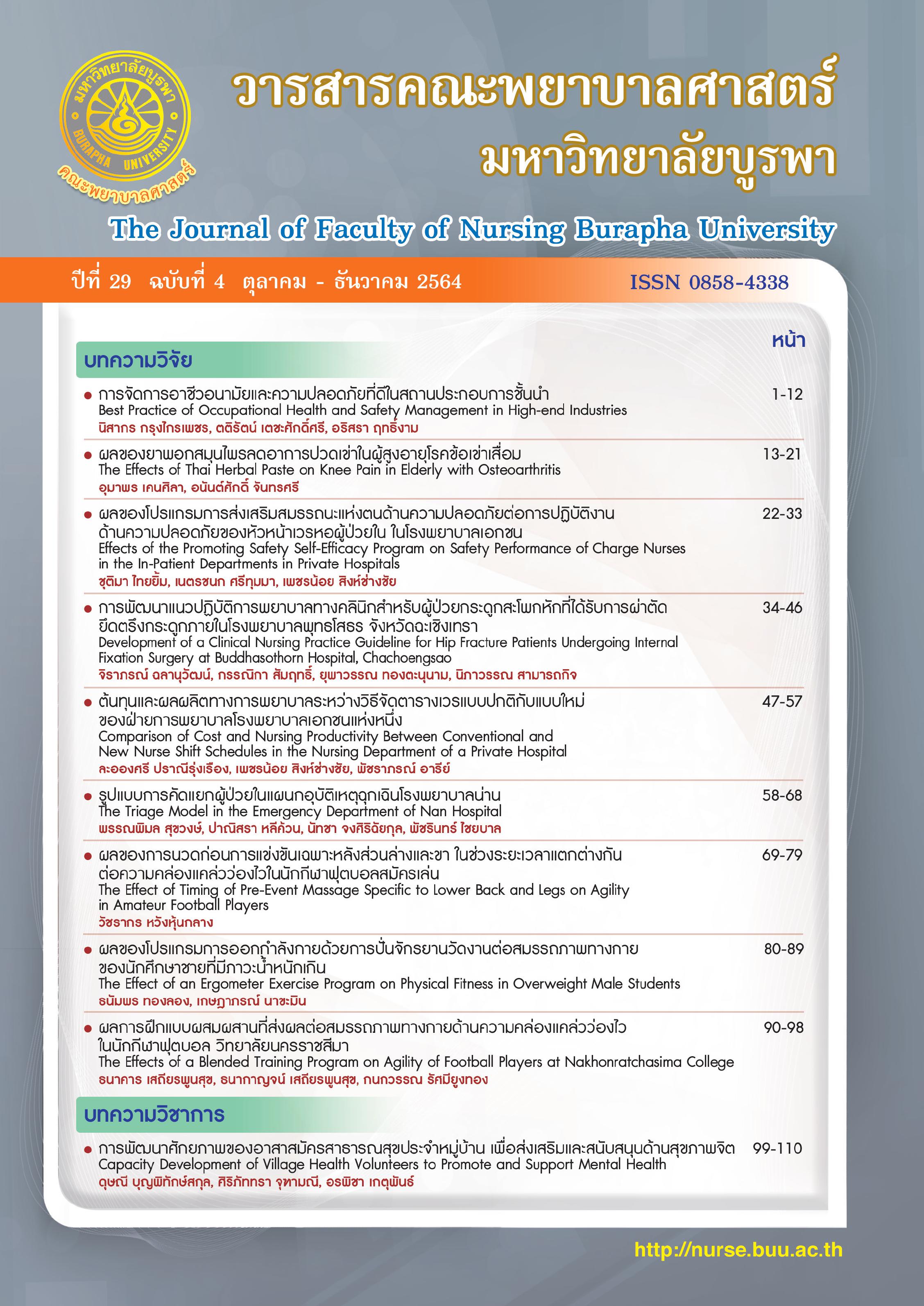ผลของการนวดก่อนการแข่งขันเฉพาะหลังส่วนล่างและขา ในช่วงระยะเวลาแตกต่างกันต่อความคล่องแคล่วว่องไวในนักกีฬา
คำสำคัญ:
การนวดก่อนการแข่งขัน, ความคล่องแคล่วว่องไว, หลังส่วนล่าง, ขา, นักกีฬาฟุตบอลสมัครเล่นบทคัดย่อ
การวิจัยครั้งนี้มีวัตถุประสงค์เพื่อเปรียบเทียบนวดก่อนการแข่งขันเฉพาะหลังส่วนล่างและขาในช่วงระยะเวลาที่แตกต่างต่อความคล่องแคล่วว่องไว กลุ่มตัวอย่างเป็นนักกีฬาฟุตบอลสมัครเล่น เพศชาย อายุ 19-24 ปี จำนวน 16 คน กลุ่มตัวอย่างจะได้รับการนวดก่อนการแข่งขันเฉพาะหลังส่วนล่างและขา 1, 2 และ 3 ชั่วโมง หลังจากนั้นทำการทดสอบความคล่องแคล่วว่องไวด้วย Semo Agility test วิเคราะห์ข้อมูลด้วยสถิติการทดสอบความแปรปรวนทางเดียวแบบวัดซ้ำ
ผลการวิจัยพบว่า ในช่วงระยะเวลาแตกต่างกันของการนวดก่อนการแข่งขันเฉพาะหลังส่วนล่างและขา 1, 2 และ 3 ชั่วโมง กลุ่มตัวอย่างมีความคล่องแคล่วว่องไวเฉลี่ยมีความแตกต่างกันอย่างมีนัยสำคัญทางสถิติที่ระดับ .001 เมื่อ เปรียบเทียบรายคู่พบว่า ความคล่องแคล่วว่องไวระหว่างนวดก่อนการแข่งขันเฉพาะหลังส่วนล่างและขา 1 และ 2 ชั่วโมง ไม่มีความแตกต่างกันอย่างมีนัยสำคัญทางสถิติ อย่างไรก็ตาม ความคล่องแคล่วว่องไวของนวดก่อนการแข่งขันเฉพาะหลังส่วนล่างและขา 3 ชั่วโมง มีความแตกต่างจาก 1 และ 2 ชั่วโมง มีความแตกต่างกันอย่างมีนัยสำคัญทางสถิติที่ระดับ .001 ผลการศึกษามีข้อเสนอแนะว่า ผู้ฝึกสอน นักกีฬา และบุคลากรในวงการกีฬา สามารถนำการนวดก่อนการแข่งขันไปใช้กับนักกีฬาฟุตบอลได้ภายในระยะเวลาไม่เกิน 2 ชั่วโมง เพื่อส่งเสริมการเคลื่อนไหวด้วยทิศทางต่าง ๆ
เอกสารอ้างอิง
Anders, J., & Kristjan, O. (2011). Integrated sports massage therapy a comprehensive handbook. China: Elsevier.
Arabaci, R. (2008). Acute effect of pre-event lower limb massage on explosive and high speed motor capacities and flexibility. Journal of Sports Science and Medicine, 7(4), 549-555.
Behm, D. G., Ket, A., Trajano, G. D., & Blazevich, A. J. (2020). Mechanisms underlying performance impairment following prolonged static stretching without a comprehensive warm-up. European Journal of Applied Physiology, 121(1), 67-94.
Benjamin, P. J., & Lamp, S. P. (2005). Understanding sports massage (2th ed). Illinois: Human Kinetics.
Chantasorn, N. (2019). Agility development by plyometric training. Humanities, Social Sciences and Arts, 12(5), 578-598. [In Thai]
Chu, Y., Zhao, Y., Hu, S., Semeah, L. M., Jia, H., Lv, T., Li, X., & Wang, R. (2020). Immediate effect of local vibration therapy for sport-induced fatigue based on traditional Chinese
medicine’s holistic theory. Journal of Multidisciplinary Healthcare, 2020(13), 1993-2001.
Goodwin, J. E., Glaister, M., Howatson, G., Lockey, R. A., & Mclnnes, G. (2007). Effect of pre-performance lower-limb massage on thirty-meter sprint running. The Journal of
Strength and Conditioning Research, 21(4), 1028-1031.
Hongsuwan, C., Eungpinichpong, W., Chatchawan, U., & Yamauchi, J. (2015). Effects of Thai massage on physical fitness in soccer players. Journal of Physical Therapy Science, 27(2), 505-508. [In Thai]
Jelveus, A., & Oddsson, K. (2011). Integrated sports massage therapy a comprehensive handbook. China: Elsevier.
Kaur, K., & Sinha, A. G. K. (2020). Effectiveness of massage on flexibility of hamstring muscle and agility of female players: An experimental randomized controlled trial.
Journal of Bodywork and Movement Therapies, 24(4), 519-526.
Krabuanrat, C. (2014). Science of coaching. Bangkok: Sintana copy center. [In Thai]
Lain, M. F. (2010). The effects of pre-competition massage on the kinematic parameters of 20-m sprint performance. Journal of Strength and Conditioning Research, 24(5),
1179-1183.
Mackenzie, B. (2005). 101 Performance evaluation tests. London: Electric Word Plc.
Mathias, H. (2012). Developing football expertise: A football-specific research review. International Review of Sport and Exercise Psychology, 5(2), 117-201.
Meedej, T. (2019). Massage for sports. Bangkok: Pimdee. [In Thai]
Norris, C. M. (2013). The complete guide to sports massage (2nd ed). London: Tim Paine.
Office of the Higher Education Commission, College of Sports Science and Technology Mahidol University (2018). The physical fitness norms of Thai university athletes. Bangkok: Media Press. [In Thai]
Ogai, R., Yamane, M., Matsumoto, T., & Kosaka, M. (2008). Effects of petrissage massage on fatigue and exercise performance following intensive cycle pedaling. British Journal of Sports Medicine, 42(10), 834-838.
Patria, H., & Gregory, K. (2005). The mechanisms of massage and effects on performance, muscle recovery and injury prevention. Sport Medicine, 35(3), 235-256.
Rosser, M. (2004). Body massage therapy basics. (2nd ed.). British: Hodder Arnold.
Sandy, F. (2013). Sports and exercise massage comprehensive care in athletics, fitness, and rehabilitation. Canada: Mosby Elsevier.
Schneider, S., Askew, C. D., Diehl, J., Mierau, A., Kleinert, J., Abel, T., Carnahan, H., & Struder, H. K. (2009). EEG activity and mood in health orientated runners after different exercise intensities. Physiology Behavior, 96(4), 709-716.
Sea Games Foundation. (2021). Sports science with athletes and coaches. Bangkok: XIII Sea Games Foundation. [In Thai]
Sintara, K., Klumkool, S., Ingkatecha, O., Jangsawang, D., & Tongkhambunchong, S. (2014). Continuous applications of Thai massage program on lower limbs promotes vertical jump in male collegiate volleyball players, Burapha University, Thailand. Australian Journal of Basic and Applied Science, 8(24), 159-163. [In Thai]





